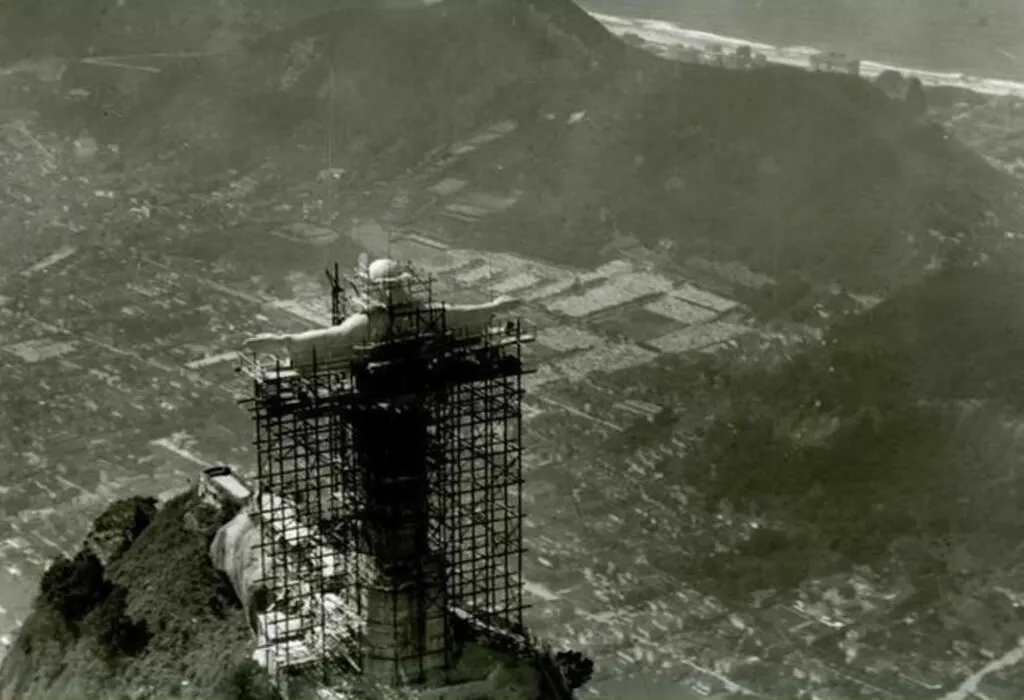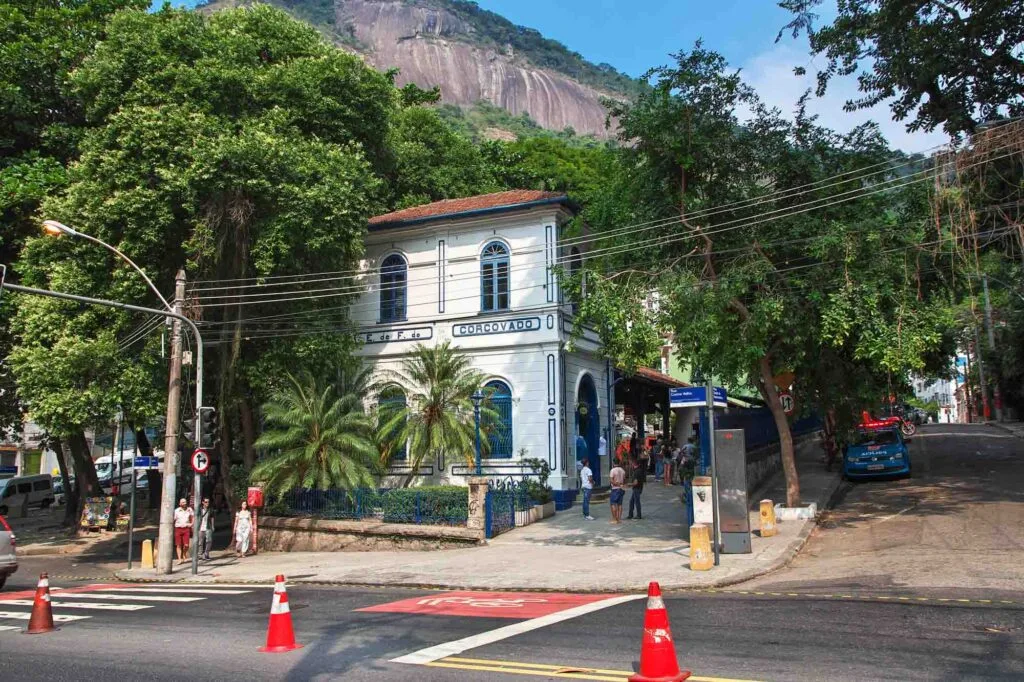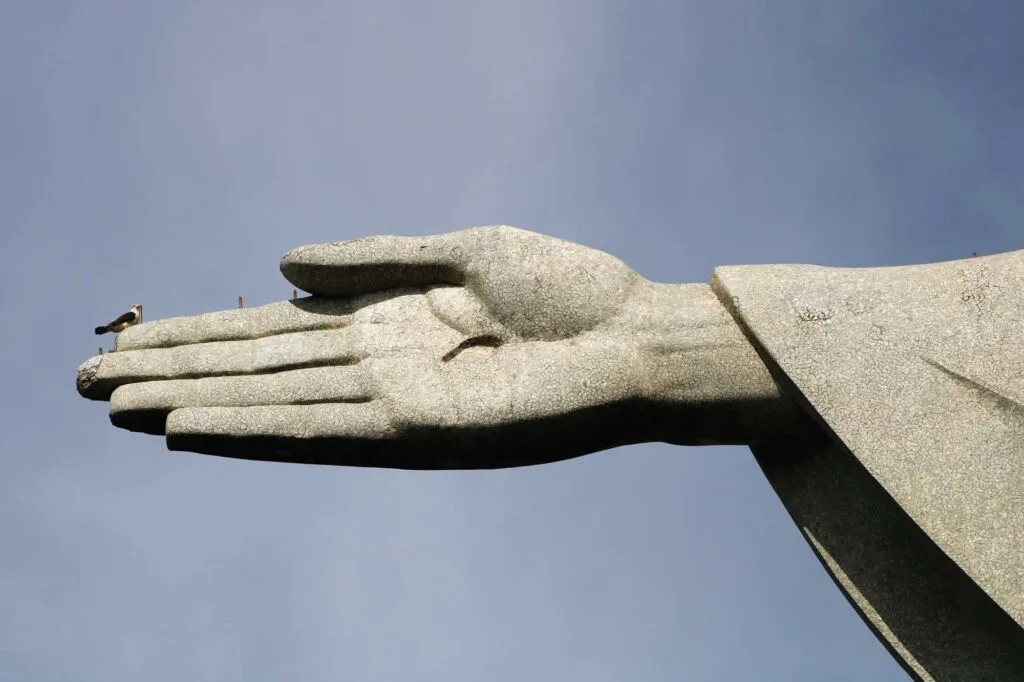Also a symbol of peace, Christ the Redeemer is arguably Brazil’s most recognizable landmark.
With arms open wide over Guanabara Bay, Christ the Redeemer receives visitants and blesses the Cariocas (aka Rio de Janeiro locals).

In today’s article, I’ll talk about Christ the Redeemer. No, it’s nothing to do with the bible—at least, not directly. This article is about the famous statue of Jesus in Rio.
Some call it the Brazilian Jesus statue or the Rio de Janeiro statue. Either way, this massive statue is one of the most iconic Brazilian landmarks and a must-visit for anyone in the country.
The Christ the Redeemer statue is an imposing religious symbol and a cultural icon watching over Rio de Janeiro City and welcoming tourists with open arms. It’s beautiful!
In this article, I discuss the history, interesting facts, and how to visit the Christ the Redeemer statue, including some tips from someone who has been there herself—me!
Epic tours including Christ the Redeemer in their itinerary
Before we dive into its history, I thought I could share my favorite experiences to visit this attraction together with other famous landmarks in the city.
Click here to check train tickets availability and timetables
Christ the Redeemer history
Although this Brazilian statue was built in 1931, its history goes way back.
In the mid-19th century, a Vincentian priest in Rio de Janeiro led a project about placing a Christian monument atop Mount Corcovado to honor Princess Isabel, the then regent of Brazil.
However, the project wasn’t approved at the time. Once the country became a republic, the project was permanently dismissed because, as you can imagine, the state was finally separated from the church.
Fast-forward 70 years, the Catholic Circle of Rio wanted to try and build a religious landmark in a city they considered to be “godless.”
So they went ahead and organized an event called Monument Week to draw donations and obtain signatures supporting the so-wanted Brazilian statue.

Obviously, most support came from Brazilian Catholics, but it was enough to finally give this project a green flag. A competition was then held so that a design could be chosen.
Among the three concepts proposed, the winner was the Christ the Redeemer statue with open arms because it was considered to be a symbol of love and peace, embracing locals and tourists alike.
This concept was created by the Brazilian engineer Heitor da Silva Costa in collaboration with Brazilian artist Carlos Oswald and French-Polish sculptor Paul Landowski.
A couple of years later, the construction of the Christ the Redeemer statue in Rio finally started under the supervision of Silva Costa. It was a major milestone in Brazilian civil engineering.

In total, it took five years to build Brazil’s most iconic statue, which isn’t that long when you consider the statue sits atop a hill. Materials, as well as workers, were transported to the summit via railway—the same one tourists use to visit the monument today.
Material-wise, the outer layers of the statue are made of soapstone, which is a material with not only beautiful color and texture but also excellent enduring qualities.
If you pay close attention to the images of this article, you’ll notice there are thousands of soapstone triangles composing the Christ the Redeemer statue.
These pieces, known as tesserae, were placed one by one on wide strips of cloth by women of Rio’s society and later glued to the concrete.
Yes, hard-working feminine hands helped to build this massive statue!

Anyway, the tesserae were intended to protect the reinforced concrete structure underneath it since the statue is located at one of the highest points in the city, which has a tropical climate.
I.e, it is exposed to intense winds and erosion all year round. Also, lightning strikes every year, which causes the tesserae to be damaged.
For this reason, the statue needs constant observation and periodic restoration, which is done by climbers from time to time.
The inauguration in 1931 happened on the day of the patron saint of Brazil, Our Lady of Aparecida.
The statue of Christ the Redeemer, the most prominent symbol of faith in Jesus ever built in the world, was considered one of the Seven Wonders, along with other important, historical, religious, and artistic landmarks in the world.

How to visit the Christ the Redeemer statue in Rio de Janeiro
If you’re traveling to Brazil, you must visit Christ the Redeemer statue in Rio de Janeiro. It’s a no-brainer.
Because it can be pretty overwhelming to look for information online, I thought I could help you plan your visit to this iconic monument.
How to get to Christ the Redeemer
Along with being a top contender on everyone’s bucket list, this new human-made wonder of the world can also be reached by train, van ride, or hiking through the Atlantic Forest in the Tijuca National Park—more on that below.

By train
Most tourists choose to visit the Christ the Redeemer statue by train because of the short but pleasant experience. This centenarian eco-friendly train takes you to the feet of the monument in about 20 minutes only, and you can sit back and enjoy the view of the world’s largest urban forest, Tijuca National Park.
This is by far the easiest and most popular option!
The Corcovado Train Station is at the Cosme Velho neighborhood. You can get there by bus or Uber, I prefer Uber because it’s easier, but that’s up to you.
Beyond that, when you buy the train ticket, you have to pick a rough boarding time, and their staff will reply with the exact boarding time. Once you’re there at the statue, you can stay as long as you want. There is no return time on your ticket.
The return works on a first-come-first-serve basis. Trains run 8 AM-4 PM.
Don’t miss out! Click here to check availability
Local tip: When going uphill, sit on the right side of the train for the best views. Likewise, when going downhill, sit on the left side. Oh, and prepare your camera!

By van
As I said, the Christ the Redeemer statue is located in the Tijuca National Park. Therefore, the park’s management company also offers a transport service to the monument.
The official vans depart from Largo do Machado Square, Lido Square, and Visitor Center Paineiras, and the ticket price varies based on your location.
All vans have air conditioning and stop at their visitor center, where they have a few shops.
Hiking
While it may sound appealing to hike to the Christ the Redeemer, especially if you’re an outdoors lover, I honestly don’t recommend it.
The trail that begins at Parque Lage is a challenging 3-hour hike through steep terrain.
On top of that, I’ve heard from friends that it isn’t safe to hike this trail. Sadly, there have been reports of robberies along the way, making this hike a gamble. Will you try your luck?
Well, my grandma used to say, “when in doubt, don’t do it,” but that’s up to you. I’m only trying to help you!

Corcovado Mountain view
Once you get out of the historic train, take the stairs to reach the statue, and take in the breathtaking view of Rio.
From the top of this 2,300-feet-tall mountain, you can see Niterói, Maracanã Stadium, Guanabara Bay, Sugarloaf Mountain, Copacabana Beach, Pedra da Gávea, and everything in between.
On the Sanctuary of Christ the Redeemer, you can clearly understand why the city of Rio de Janeiro is called the Marvellous City.
It’s absolutely mind-blowing!


Tips for visiting Christ the Redeemer statue
- Avoid peak season: Weekends, national holidays, and school vacations (mid-December through late-January and July) are usually peak times. So avoiding these days gives you more chance of experiencing this place without the crowds.
- Visit in the early morning: The statue stands atop one of the highest points in Rio de Janeiro, and there is little to no cover, so you will want to visit it as early as possible to avoid the scorching sun and possibly (hopefully) the crowds.
- Buy your tickets in advance: Purchasing your tickets in advance is key. Even if you are visiting in the low-season, chances are you will find long queues there. I’ve visited Christ the Redeemer twice myself, and both visits were in the low-season, yet I had to wait in line for at least 45 minutes. Not cool.
- Stop by the chapel: You won’t want to miss the Our Lady Aparecida Chapel underneath the statue. It’s small but cute.
- Watch out for your belongings: As with any tourist attraction in Brazil or in the world, pickpockets are everywhere, just waiting for an opportunity to act. Don’t let yourself be an easy target.
- Bring a hat, sunscreen, and water: Fortunately, it is often sunny and warm in Rio de Janeiro. As a tourist, I’m sure that’s the weather you would expect. Still, that can be pretty unbearable at times, especially in the summer. So pack some essentials and take good care of yourself!

Quick Christ the Redeemer facts
- Christ the Redeemer statue meaning: peace
- Portuguese name: Cristo Redentor
- Statue height: 98 feet (30 m)
- Pedestal height: 27 feet (8 m)
- Total monument height: 125 feet (38 m)
- Statue width: 92 feet (28 m)
- Statue weight: 625 long, 700 short tons (635 metric tons)
- Corcovado Mountain height: 2,300 feet (700 m)
- Materials: Concrete and soapstone
- Daily visitors: 5,000 on average (about 2 million in a year)
- Completion date: October 12, 1931
Other fun facts about the Christ the Redeemer statue
The Jesus statue in Rio is the world’s third-largest statue, only after Christ the King in Poland and Cristo de la Concordia in Bolivia.
There is a heart inside Christ the Redeemer, which measures 4.2 feet (1.30 m). Inside this heart, there is a glass bottle with a parchment that contains the family tree of the tax engineer Pedro Fernandes and the master of works, Heitor Levy.
According to the National Institute of Space Research (INPE), the statue is struck by lightning around six times a year. See image below.

Wrapping up on the Christ the Redeemer statue
Standing atop the Corcovado Mountain, the Christ the Redeemer statue is a unique Art Deco figure in the country and the world.
Watching over one of the trendiest cities in Brazil, the statue of Christ the Redeemer embraces locals and tourists alike.
If you’re planning to visit Brazil, be sure to book your train ticket in advance and prepare yourself to take in jaw-dropping views of Rio. You won’t regret it. Not for a second!
Did you enjoy this article about the Brazilian statue Christ the Redeemer? Then share it with a friend who might like it too!
